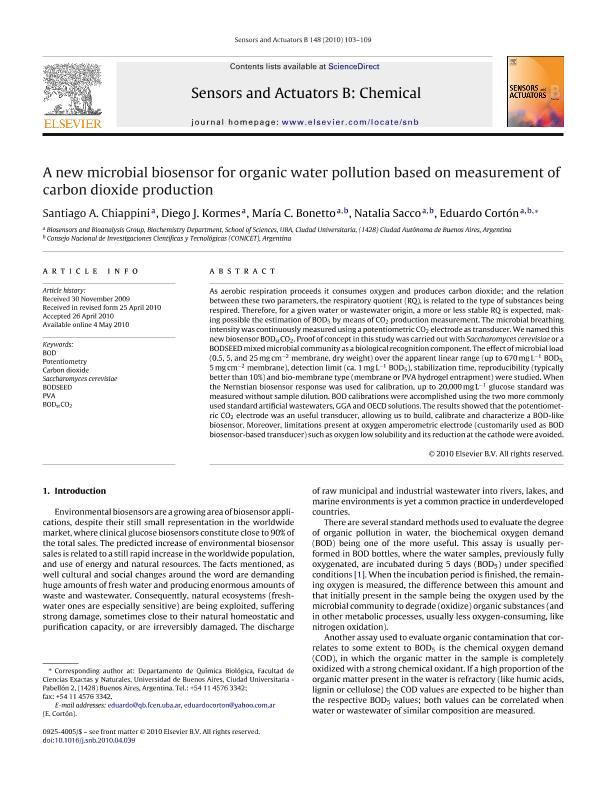Artículo
A new microbial biosensor for organic water pollution based on measurement of carbon dioxide production
Chiappini, Santiago Andrés ; Kormes, Diego J.; Bonetto, Maria Celina
; Kormes, Diego J.; Bonetto, Maria Celina ; Sacco, Natalia Jimena
; Sacco, Natalia Jimena ; Corton, Eduardo
; Corton, Eduardo
 ; Kormes, Diego J.; Bonetto, Maria Celina
; Kormes, Diego J.; Bonetto, Maria Celina ; Sacco, Natalia Jimena
; Sacco, Natalia Jimena ; Corton, Eduardo
; Corton, Eduardo
Fecha de publicación:
06/2010
Editorial:
Elsevier Science SA
Revista:
Sensors and Actuators B: Chemical
ISSN:
0925-4005
Idioma:
Inglés
Tipo de recurso:
Artículo publicado
Clasificación temática:
Resumen
As aerobic respiration proceeds it consumes oxygen and produces carbon dioxide; and the relation between these two parameters, the respiratory quotient (RQ), is related to the type of substances being respired. Therefore, for a given water or wastewater origin, a more or less stable RQ is expected, making possible the estimation of BOD5 by means of CO2 production measurement. The microbial breathing intensity was continuously measured using a potentiometric CO2 electrode as transducer. We named this new biosensor BODstCO2. Proof of concept in this study was carried out with Saccharomyces cerevisiae or a BODSEED mixed microbial community as a biological recognition component. The effect of microbial load (0.5, 5, and 25 mg cm-2 membrane, dry weight) over the apparent linear range (up to 670 mg L-1 BOD5, 5 mg cm-2 membrane), detection limit (ca. 1 mg L-1 BOD5), stabilization time, reproducibility (typically better than 10%) and bio-membrane type (membrane or PVA hydrogel entrapment) were studied. When the Nernstian biosensor response was used for calibration, up to 20,000 mg L-1 glucose standard was measured without sample dilution. BOD calibrations were accomplished using the two more commonly used standard artificial wastewaters, GGA and OECD solutions. The results showed that the potentiometric CO2 electrode was an useful transducer, allowing us to build, calibrate and characterize a BOD-like biosensor. Moreover, limitations present at oxygen amperometric electrode (customarily used as BOD biosensor-based transducer) such as oxygen low solubility and its reduction at the cathode were avoided.
Palabras clave:
BOD
,
BODSTCO2
,
BODSEED
,
CARBON DIOXIDE
,
POTENTIOMETRY
,
PVA
,
SACCHAROMYCES CEREVISIAE
Archivos asociados
Licencia
Identificadores
Colecciones
Articulos(IQUIBICEN)
Articulos de INSTITUTO DE QUIMICA BIOLOGICA DE LA FACULTAD DE CS. EXACTAS Y NATURALES
Articulos de INSTITUTO DE QUIMICA BIOLOGICA DE LA FACULTAD DE CS. EXACTAS Y NATURALES
Articulos(IQUIFIB)
Articulos de INST.DE QUIMICA Y FISICO-QUIMICA BIOLOGICAS "PROF. ALEJANDRO C. PALADINI"
Articulos de INST.DE QUIMICA Y FISICO-QUIMICA BIOLOGICAS "PROF. ALEJANDRO C. PALADINI"
Articulos(OCA CIUDAD UNIVERSITARIA)
Articulos de OFICINA DE COORDINACION ADMINISTRATIVA CIUDAD UNIVERSITARIA
Articulos de OFICINA DE COORDINACION ADMINISTRATIVA CIUDAD UNIVERSITARIA
Citación
Chiappini, Santiago Andrés; Kormes, Diego J.; Bonetto, Maria Celina; Sacco, Natalia Jimena; Corton, Eduardo; A new microbial biosensor for organic water pollution based on measurement of carbon dioxide production; Elsevier Science SA; Sensors and Actuators B: Chemical; 148; 1; 6-2010; 103-109
Compartir
Altmétricas



